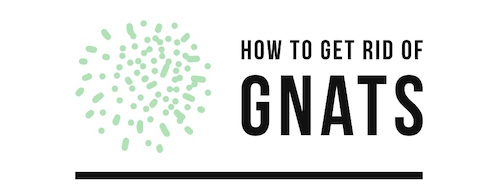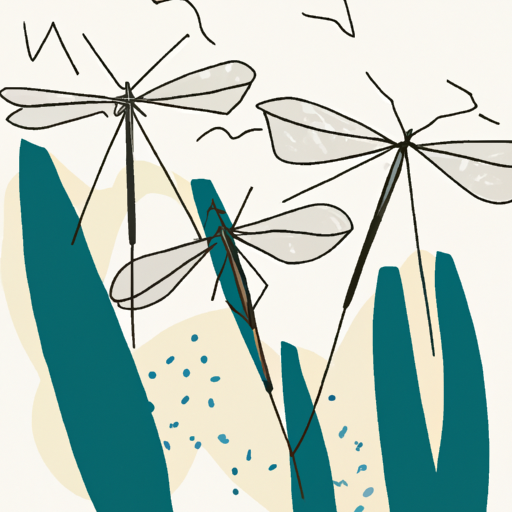How to Identify Gnats in Plants
Gnats are small, flying insects that can be found in and around plants. They are often mistaken for fruit flies, but they are actually different species. Gnats can cause damage to plants by feeding on the leaves and stems, as well as transmitting diseases. Identifying gnats in plants is important for controlling their population and preventing further damage to the plant.
To identify gnats in plants, look for small black or gray insects hovering around the plant or flying away when disturbed. These insects may also be seen crawling on the surface of the soil or on leaves and stems of the plant. If you suspect an infestation of gnats, inspect your plant closely with a magnifying glass to confirm their presence.
Gnats lay eggs near moist areas such as soil or decaying organic matter like compost piles or mulch beds near your plants. The eggs hatch into larvae which feed on decaying organic matter before emerging as adults after several weeks. To prevent an infestation of gnats, keep your garden free from excess moisture by avoiding overwatering and removing any standing water sources near your plants. Additionally, remove any dead leaves or other debris from around your garden that could provide food sources for these pests.
Natural Ways to Get Rid of Gnats in Plants
Gnats are a common problem in houseplants, but they can be eliminated without the use of harsh chemicals. Here are some natural ways to get rid of gnats in plants:
1. Remove any decaying plant material from the soil and dispose of it properly. This will help reduce the number of gnats that may be present in your plants.
2. Increase air circulation around your plants by moving them away from walls and other objects that may block airflow. This will help prevent new gnat infestations from occurring.
3. Place yellow sticky traps near your plants to catch adult gnats as they fly around looking for food or mates. These traps should be replaced regularly to ensure effectiveness against new generations of gnats that may hatch over time.
4. Make a homemade insecticidal soap spray by mixing one tablespoon of dish soap with one quart of water and spraying it directly onto affected areas on your plants where you see signs of gnat activity (such as leaves or stems). Be sure to spray both sides of each leaf for maximum effectiveness against these pests!
5. Introduce beneficial nematodes into the soil surrounding your plant’s roots, which will feed on larvae and eggs found there, helping to reduce their numbers over time naturally without harming other beneficial insects or animals in the area like chemical treatments might do!
6 Finally, make sure you’re watering your plants correctly – too much water can create an ideal environment for these pests to thrive so make sure you’re not overwatering!
Common Causes of Gnat Infestations in Plants
Gnat infestations in plants can be caused by a variety of factors. The most common causes include:
1. Overwatering: Gnats are attracted to moist soil and can quickly reproduce in overly wet conditions. To prevent gnat infestations, it is important to water plants only when the soil is dry and avoid overwatering.
2. Poor Drainage: Poor drainage can lead to standing water, which attracts gnats and other pests. Make sure that your plant’s pot has adequate drainage holes so that excess water can escape easily.
3. Compost or Manure: Compost or manure used as fertilizer may contain gnat larvae, which will hatch into adult gnats if not properly treated before use on plants. It is important to use compost or manure that has been aged for at least six months before applying it around your plants to reduce the risk of an infestation occurring from this source.
4. Overfertilizing: Too much fertilizer applied too often can create an ideal environment for gnats to thrive in due to the high levels of nitrogen present in fertilizers, which provide a food source for them as well as encouraging rapid plant growth that provides shelter for them from predators such as birds and spiders . To prevent this problem, it is best practice to fertilize sparingly and only when necessary according to the instructions on the product label .
The Benefits of Beneficial Insects for Controlling Gnats in Plants
Beneficial insects can be a great way to control gnats in plants. These insects, such as ladybugs, lacewings, and parasitic wasps, feed on the larvae of gnats and other pests that can damage plants. By introducing beneficial insects into your garden or greenhouse, you can reduce the number of gnats in your plants without using chemical pesticides.
Beneficial insects are an effective form of pest control because they target only the pests that are causing damage to your plants. They do not harm beneficial organisms like bees and butterflies that help pollinate flowers or other helpful bugs like spiders that eat harmful pests. This means you don’t have to worry about harming beneficial species while trying to get rid of gnats in your garden or greenhouse.
In addition to being safe for beneficial species, using beneficial insects is also more cost-effective than chemical pesticides. Beneficial insect populations can be maintained with minimal effort and expense since they reproduce quickly and require little maintenance once established in an area. Furthermore, since these insects only target specific pests, you don’t have to worry about over-spraying areas with chemicals which could lead to environmental contamination or health risks for humans and animals alike.
Finally, by introducing beneficial insects into your garden or greenhouse you will create a balanced ecosystem where natural predators keep pest populations under control without the need for chemical intervention. This will help ensure healthy plant growth while reducing the amount of time spent dealing with pest problems in the future!
Tips for Preventing and Treating Plant Diseases Caused by Gnats
Gnats are small flying insects that can cause a variety of plant diseases. To prevent and treat these diseases, it is important to understand the life cycle of gnats and how they spread disease. Here are some tips for preventing and treating plant diseases caused by gnats:
1. Monitor your plants regularly for signs of infestation. Look for small white or yellow spots on leaves, wilting or discolored foliage, or stunted growth. If you notice any of these signs, take action immediately to prevent further damage to your plants.
2. Keep the area around your plants clean and free from debris such as fallen leaves or rotting fruit that can attract gnats.
3. Use sticky traps to catch adult gnats before they lay eggs in the soil around your plants’ roots where larvae will feed on them causing root rot and other diseases.
4. Introduce beneficial insects such as ladybugs into your garden which will feed on adult gnats reducing their population size significantly over time without using chemicals which could harm other beneficial insects in the garden ecosystem like bees and butterflies .
5 . If you have an infestation, use an insecticidal soap spray specifically designed for controlling soft-bodied pests like aphids, mealybugs, thrips ,and whiteflies which also work well against gnat larvae . Be sure to follow label instructions carefully when applying this product as it can be toxic if used incorrectly .
6 . For more severe infestations , use a systemic insecticide containing imidacloprid which is absorbed by the plant’s roots killing both adults and larvae before they have a chance to cause damage . Again , be sure to follow label instructions carefully when applying this product as it can be toxic if used incorrectly .

